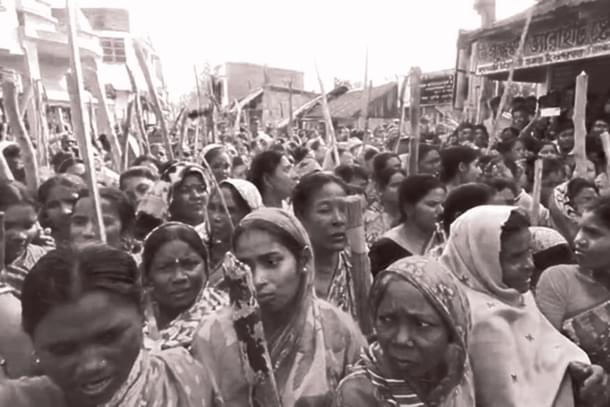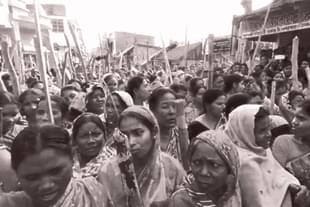West Bengal
Sandeshkhali Tyranny: Rohingyas As Enforcers, Hindus As Victims
Jaideep Mazumdar
Feb 12, 2024, 09:11 PM | Updated Feb 13, 2024, 01:39 PM IST
Save & read from anywhere!
Bookmark stories for easy access on any device or the Swarajya app.


The atrocities suffered by the ordinary folks of Sandeshkhali at the hands of Trinamool cadres have been reported extensively over the past couple of days.
But what has remained hidden so far is the role of Rohingyas in the subjugation of Hindus, including Dalits and tribals, in Sandeshkhali.
As in the rest of Bengal, Muslims form about a third of the population in Sandeshkhali. Many of them are illegal immigrants, or descendants of illegal immigrants, from East Pakistan and then Bangladesh.
Though a minority, Muslims play a decisive role in Sandeshkhali. Thanks to the patronage of the Trinamool leadership, Muslim crime lords--the most powerful among them is Sheikh Shahjahan--wield unchecked authority in Sandeshkhali.
What’s shocking is that Rohingyas form the backbone of Sheikh Shahjahan’s--and by extension, the Trinamool’s--dominance.
Rohingyas started entering Bengal around seven years ago, primarily through the riverine and porous borders in South and North 24 Parganas districts of south Bengal.
Trinamool functionaries are alleged to have not only facilitated their illegal entry into Bengal through the international border, but also provided them shelter and aid. Later, all these Rohingya infiltrators received ration cards and Aadhaar cards based on fake or forged documents like birth certificates, residential certificates, school certificates etc issued by pliant local authorities.
In return, the Rohingyas have provided their benefactors the muscle power to keep their political rivals in a state of subjugation.
Rohingyas have earned notoriety for their involvement in criminal activities in their native Myanmar and also in Bangladesh which has provided refuge to lakhs of them.
Krishnapada Mandal, a resident of Garia in south Kolkata, was born and grew up in Sandeshkhali. He worked as a teacher in a few government schools in and around Kolkata and settled down in Garia after retirement. But he has close relatives in Sandeshkhali and goes and stays there often.
“The Rohingyas started coming here around seven to eight years ago. They were provided shelters, food, clothes, utensils and other necessities by Trinamool leaders and local officials. Sheikh Shahjahan took the lead in helping them,” Mandal told Swarajya.
The Rohingyas slowly grew in numbers and were employed in the bheris (fish farms) and farmlands by Trinamool functionaries. They also found employment as labourers and as rickshaw pullers, vegetable sellers etc.
Hiran Das, an employee of a courier company who hails from Sandeshkhali, told Swarajya: “Right from the very beginning, the Rohingyas were a menace. They used to tease Hindu women and even attempted to molest Hindu girls a few times. They were provided blanket protection by Trinamool leaders, especially Shahjahan”.
The Trinamool members who used to pick up Hindu girls and women and deliver them to Trinamool leaders were mostly Rohingyas.
“We have never had any problems with local Muslims, many of whom have been here for generations. Even the (illegal) migrants from Bangladesh are not troublemakers and have never created any problems for us. But things changed once the Rohingyas started coming. All the trouble started then,” said Shamik Biswas, a farmer who is also a CPI(M) functionary.
Sandeshkhali was a CPI(M) stronghold and some pockets of Basirhat (Sandeshkhali is a part of Basirhat sub-division of North 24 Parganas district) still remain so.
“When the Left was in power, CPI(M) muscle men also used to suppress us, but only politically. As long as we supported the CPI(M) and kept a distance from other parties, they left us alone. They never committed the sort of atrocities that we are subjected to now at the hands of Trinamool leaders and cadres,” said Shankar Prasad Das, a retired schoolteacher.
The land grabs and the atrocities on women by Trinamool leaders (read this) never happened during Left rule. “The Marxists were a disciplined lot and were only interested in political power. They also lived by certain principles. But the Trinamool leaders and cadres are unprincipled, vile, corrupt, and completely undisciplined. They have no ideology and are totally immoral and unscrupulous,” said Das.
Hindu women of Sandeshkhali confess that their tormentors are mostly Rohingyas. “There have been many cases of Rohingya men molesting our (Hindu) girls in the presence of their own womenfolk--their wives, mothers or daughters. What is shocking is that the Rohingya women actually encourage their men to harass and commit crimes against Hindu women because we are kafirs in their eyes,” said the wife of a petty trader who has suffered atrocities at the hands of Trinamool leaders.
Many other Hindu women who spoke to Swarajya recounted similar experiences and said that the Rohingyas have become the biggest source of fear and torment for them.
“Sandeshkhali will never be safe for women as long as a single Rohingya is present here,” said the same lady.
It is not very difficult to detect the Rohingyas, especially for someone with a good knowledge of the Bengali dialects of Bangladesh.
That’s because Rohingyas speak a dialect that is a corruption of Chatgaiya that is spoken in Chittagong province of Bangladesh. Myanmar’s Rakhine state, which lies to the south of Chittagong province, is where the Rohingyas have come from.
This correspondent came across a young man at Metekhali Bazar, an hour’s drive away from Sandeshkhali, at a tea stall. He was speaking in the Rohingya dialect.
Initially, he denied that he was speaking in Rohingya and tried to switch over to the Bangla spoken in Bengal, but did not succeed. He then confessed that his parents are from Chittagong. But when this correspondent pointed out the differences between Chatgaiya and Rohingya dialects, the young man who gave his name as Abdul (he refused to give his last name) glowered and walked away.
While Sandeshkhali remains out of bounds for the media, this correspondent could spot Rohingyas in a number of surrounding areas in Basirhat sub-division.
It is not very difficult to spot the Rohingyas. Their facial features are different from locals, both Hindus and Muslims. The two Bengali communities share similar facial and physical features that are distinct from the Rohingyas.
The dead giveaway is, of course, their dialect. Even those Rohingyas who have stayed here for a few years speak Bangla with a distinct Rohingya intonation and accent that is not difficult to detect.
Interestingly, while Bengali Muslim crime lords in Sandeshkhali and other places in Bengal use Rohingyas as their foot soldiers to carry out crimes, they also maintain a distance from the Rohingyas.
The Bengali Muslims do not interact socially with the Rohingyas; they even discourage the Rohingyas from praying in their mosques. They do not allow girls and women of their families to interact with Rohingyas, and there is no question of allowing Rohingyas to marry into their families.
That’s because they (the Bengali Muslims) too have a poor opinion of Rohingyas.
What is most regrettable in this entire cycle is the support the Rohingyas receive from functionaries of the state and local government.





